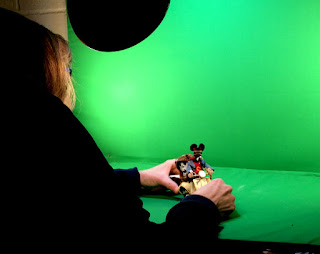Tuesday Musings - The Making of a Stop Motion Film, Pt. 1
Animation is a huge subject, comprising many different techniques. It would be impossible to give a detailed history and analysis in this blog, so instead I'm going to give a brief and simple breakdown of one animation method to start with: stop motion (as I use it).
A good part of my output uses stop motion, a true "animation" technique, in that animating something means literally to give it life, or at least the appearance of life through video in this case. Since all video and film can be broken down into individual frames, that is what makes it possible to do stop motion. Remember those flipbook cartoons you did when you were a kid? Those are basically a film broken down into individual frames, and those frames blend together in sequence when you flip the booklet.
In stop motion, you take a still picture of a figure; move the figure ever-so-slightly and take another still picture; repeat. My films generally need between 15 and 30 such stills to make one second of video! It can be quite painstaking work. These stills are then loaded sequentially into a video program and the result is like a flip cartoon when scrubbed (scrolled through) or played. That is the most simple breakdown of the process. It is, of course, a bit more complicated than that in reality, needing attention to lighting, light flicker, shadows, bumping characters (and the camera!), breaking down simple actions into tiny components, constructing a jointed character, backgrounds, etc. However, in its simplest form it is simply a photographic flipbook.
Like any narrative film, stop-motion characters are supremely important. I'll outline how my characters are built, costumed and animated next Tuesday, but today I'll give a bit of background on backgrounds!
I employ two types of background: the first is an actual constructed "diorama" or scene in miniature, as seen here for Shakespeare's house:
By far the most common background I use, though, is made through the wizardry of green screen or Chromakey. The figures are filmed against a solid coloured background (usually green, but actually can be any consistent colour not found on the puppets), which is then erased by software and replaced with a background that I have made, either static or video. Here I am filming against a green screen (this is for a scene from the web series):
Again, no festival updates this week, but I'm pleased to announce that I am able to work with the other form of animation that I employ (2D motion graphics) one-handed, although somewhat slower than usual! "Joyfully" (working title) is a happy mix of music, art and dance. No completion date; just working on it as I can; it's keeping me somewhat sane during recovery.
A good part of my output uses stop motion, a true "animation" technique, in that animating something means literally to give it life, or at least the appearance of life through video in this case. Since all video and film can be broken down into individual frames, that is what makes it possible to do stop motion. Remember those flipbook cartoons you did when you were a kid? Those are basically a film broken down into individual frames, and those frames blend together in sequence when you flip the booklet.
In stop motion, you take a still picture of a figure; move the figure ever-so-slightly and take another still picture; repeat. My films generally need between 15 and 30 such stills to make one second of video! It can be quite painstaking work. These stills are then loaded sequentially into a video program and the result is like a flip cartoon when scrubbed (scrolled through) or played. That is the most simple breakdown of the process. It is, of course, a bit more complicated than that in reality, needing attention to lighting, light flicker, shadows, bumping characters (and the camera!), breaking down simple actions into tiny components, constructing a jointed character, backgrounds, etc. However, in its simplest form it is simply a photographic flipbook.
Like any narrative film, stop-motion characters are supremely important. I'll outline how my characters are built, costumed and animated next Tuesday, but today I'll give a bit of background on backgrounds!
I employ two types of background: the first is an actual constructed "diorama" or scene in miniature, as seen here for Shakespeare's house:
 |
| Test shot |
 |
| As used in film, with appropriate lighting |
 |
| Yep, they're tiny characters! |
...and here is a comparison of an original frame and the same frame with a background keyed in:
I absolutely love chromakey as I can create virtually any background or world that I need or want!
NEXT TIME: Stop Motion part 2: how my characters are created!






Comments
Post a Comment